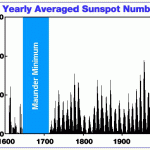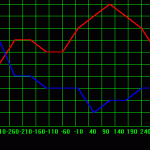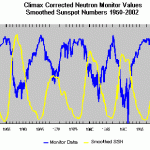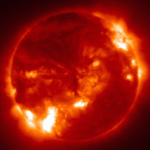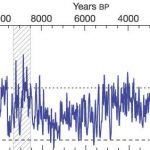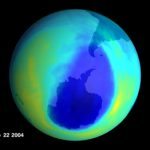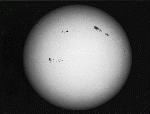John E. Beckman, and Terence J. Mahoney
Instituto de Astrofísica de Canarias, E-38200 La Laguna, Tenerife, Spain
Abstract:
We discuss how, in the 1970’s, Eddy took clues from the historical researches of Spörer and Maunder in the 19th century to draw attention to the virtual absence of sunspot activity between 1645 and 1715. This “Maunder Minimum” is not only of interest to solar physicists in the context of the theory of solar magnetic activity, and to stellar astrophysicists working on the properties of cool stars, but may also be a vital clue to the influence of the variability of the Sun’s power output on terrestrial climate. Without the availability of the historical documentary records the long-term variability of the Sun implied by the Maunder Minimum would not have come to light, and the consequent advances in stellar physics and in palaeoclimatology would not have been possible.
1. Introduction: the Solar Cycle and its Variation
We are all familiar with the 11-year sunspot cycle. One familiar factor is the effect of solar activity on short-wave radio communications. During sunspot maximum high-energy protons and alpha particles from the Sun affect the ionosphere, reducing its effectivity as a mirror from which short radio waves are reflected round the world, disrupting transmissions for days at a time. The association with the presence of large numbers of dark spots on the solar disc is widely known, and well understood, and it is also clear that such maxima repeat every 10 or 11 years, with minima between them. More specialized is the knowledge that this cycle was discovered only some 150 years ago by Schwabe (1843), and put on a firm observational basis during the last century by Wolf (1856, and subsequent papers, summarized in Waldmeier 1961). Even more specialized, at least until the need to understand climate change pushed it to the fore in the 1980’s, was the belief that the present solar cycle might not be a permanent feature of solar behaviour. The key impulse here was the work of Eddy in the late 1970’s, focused especially on the historical period between 1645 and 1715, for which there is evidence that sunspot activity was strongly suppressed or virtually absent. If this is accepted as true, it has strong implications for our ideas of how magnetic fields in stars are produced. Of more impact, it might go some of the way, even all of the way, to explaining the observed pattern of global warming of the Earth in the last decades of the 20th century. This makes the “discovery ”of more than academic interest. Since it would not have been possible to study solar phenomena in the 17th century without the appropriate records, the importance of such records in this case ought to be readily apparent. The reason for the remaining discussion is to give sufficient detail to show how well founded in fact is the proposition that sunspot activity was virtually absent for some 70 years during the period cited. If there are doubts due to inadequacy of the record these can only serve to reinforce the importance of maintaining complete archives in the general case, and any debate within our presentation is confined to the climatic significance of the findings, rather than dealing with the relevance of archive material, which we regard as obvious.
2. Sunspots in the late 17th Century: Evidence of Absence, or Absence of Evidence?
The possible absence of sunspots for some 70 years in the 17th century was first pointed out by the Spörer (1887) using the extensive compilation of data by Wolf (1856, 1868). Spörer’s work was summarized by Maunder (1890, 1894), who commented, following Clerke (1894), that this dearth of sunspots apparently coincided with an absence of terrestrial aurorae. We now know that aurorae are caused by sub-atomic particles emitted by the Sun during releases of magnetic energy which often accompany sunspots. To supplement Spörer’s use of Wolf’s data, Maunder quotes the editor of Philosophical Transactions describing the observation of a sunspot in 1671 by Cassini in Paris with the comment that it was the first seen for many years. Much later, Maunder (1922) found a note by Flamsteed, the first Astronomer Royal, describing a sunspot seen at Greenwich in 1684, in which Flamsteed says that it is the first he had seen since 1674. Flamsteed made several other references to this spot and to his solar observations in general in his correspondence, the definitive edition of which is now nearing completion (Flamsteed 1995). Maunder also took evidence from Herschel (1801), who had referred to Lalande’s (1792) L’Astronomie in which detailed evidence relating to the absence of sunspots in the latter part of the 17th, and early 18th century was cited.
In spite of Spörer’s, and especially Maunder’s advocacy, most specialists were fairly sceptical about the reliability of a prolonged sunspot absence. This scepticism, first propounded by Herschel (1801), was pressed strongly by Luby (1942); both claimed that the main reason for few reports of sunspots from 1650 to 1715 was that people were not observing the Sun, or at any rate not systematically. Eddy (1976) set out to show that this had not in fact been the case. After setting the scene by decribing Rosa Ursina (Scheiner 1626-30), in which methods of observing sunspots and their accompanying bright “faculae” were painstakingly described, he describes the best known solar observers of the Sun during the 17th century, and briefly outlines their work. Among the most important was Hevelius of Dantzig, who published a major study in 1679 describing observations of the solar surface made continually between 1652 and 1685, Picard in Paris made systematic observations of the Sun every clear day from 1653 to his death in 1685, succeeded by La Hire, who if anything was even more assiduous, continuing Picard’s work until his own death in 1718. Flamsteed was also a persistent solar observer between 1676 and 1699. It was largely based on the work of these observers, supplemented by others in Italy, that Spörer (1887) constructed a table of all the sunspots noted between 1672 and 1699. He found less than 50, whereas in any typical 30-year interval during the past hundred years there have been between 40,000 and 50,000 spots reported. As well as the low levels of activity before 1715, there are well attested reports, notably by La Hire in France and Derham in England, of the surge in sunspot activity which occurred during and after that year, in which sunspots returned to the solar surface in the quantities which we take to be normal today. Indirect supporting evidence for the absence of activity in the late 17th century, and of its resurgence in the early 18th century, comes from the record of auroral sightings. However Eddy (1976) admits that the increase in systematic reports of aurorae in countries “advanced” scientifically in the 18th century could readily be attributable to an increase in informed reporting rather than a true increase.
By his paper in Science, Eddy (1976) succeeded in convincing many researchers that there was real evidence for the sunspot absence in the Maunder Minimum period (and incidentally coined the term Maunder Minimum by which the period has become known, and which proved a neat sales slogan). His article did add some interesting extra touches, such as an attempt to show that the solar corona at eclipse during the period was strongly suppressed compared with its present exhibition of major streamers. He also looked at the tree-ring 14C record, using the hypothesis that in the absence of solar activity the high energy cosmic rays which produce 14C in the atmosphere penetrate to circumterrestrial space in greater fluxes, being less repelled by the solar wind. One would expect higher levels of 14C in rings formed during sunspot minimum, at the present epoch, and a fortiori in rings formed during the prolonged Maunder Minimum. Using this as evidence, Eddy confirmed the Maunder Minimum, as well as an earlier “Spörer minimum” in the early 16th century, and a major maximum of sunspot activity spanning the 12th and 13th centuries.
3. The Maunder Minimum and Climate Change
While there has not been great resistance to Eddy’s arguments for a lull in solar magnetic activity during the Maunder Minimum, one of the main reasons why his ideas caught the imagination is more contentious. He claimed that the Maunder Minimum coincided in time with an era of colder weather, and that by implication the absence of magnetic activity was accompanied by a net fall in the total radiative output of the Sun. An implicit corollary is that in the intervening period the radiative output has been increasing, with a consequent warming of the Earth. This basic idea has been taken up by a section of the solar physics community, and a good recent summary of the evidence for the proposition that solar variability is an agent, if not the main agent, of the perceived recent climate change associated with global warming, is given in Hoyt & Schatten (1997).
One should be wary of jumping to conclusions about the role of greenhouse gases in our atmosphere in procuring a generalized warming of the Earth, given the great complexity of physical processes inherent in the reaction of the atmosphere-ocean system to a change in atmospheric transparency, knowing that such a change is in fact occurring as a result of the emission of gases in industry and transport. To this area of doubt the advocates of solar global warming have been able to add their element of confusion. Maybe we are experiencing a steady rise in the solar constant, accompanying a similar rise in solar magnetic variability, and maybe the greenhouse effect is not the main agent, or even a cause, of global warming. The novelty of the use of the Maunder Minimum in this context is the hypothesis that the time-scale associated with any change may be of order hundreds rather than tens of years, which would be the scale for changes directly linked to individual 11- or 22-year cycles.
4. Magnetic Cycles in Late-type Stars: Maunder minima?
Starting in the 1960’s at the Mt. Wilson Observatory O.C. Wilson (sic) began a long-term study of magnetic cycles in cool stars using as his observational indicator the variable emission flux of the H and K resonance lines of ionized calcium whose appearance in emission is characteristic of stellar chromospheres. There is an excess of H and K emission in the faculae which surround sunspots, and epochs of sunspot maximum coincide with epochs of maximum H and K. If the Sun were a distant star, we could observe its 11-year cycle as a variation in integrated H+K flux with this period and with a peak-to-peak amplitude some 30% of the mean. Wilson set out to see whether stars of similar spectral type and luminosity class (i.e. similar surface temperature and mass) show comparable variations. This entailed a major project, the monitoring of the fluxes of a group of stars during decades. Wilson’s project was taken up by his students and successors, notably by Vaughan and by Baliunas, with the result that there are now well sampled records of H+K intensity for over a hundred stars covering 30 years, plus samples of many hundreds more, including coeval starclusters, covering the past 15 years. A full summary of the project and its results is given in Baliunas et al. (1998). One of the manifold implications of these results is the possible detection of Maunder minima in Sun-like stars.
In very broad terms, for two similar stars the one which rotates faster will have a stronger magnetic field, and also stronger H+K emission. Again, in general terms, the older a star the slower it rotates. Thus H+K emission is an indicator of age, and has been calibrated against open stellar clusters, whose ages can be determined via collective photometry of their complete populations. One obvious problem here is that if a star shows H+K variability, with amplitude similar to that of the Sun, say, a single measurement which catches the star at a maximum or minimum will give a misleading age estimate; what is required is a mean over a stellar cycle, or over a long enough period to cover short-term variations. In a cluster these effects can be cancelled even at a single epoch by averaging over its population, but for a single star this is not possible. The situation is worsened if stars have Maunder minima, because a measurement of H+K during a Maunder minimum would give the false impression of very low activity, and very great age. Stars with low activity have indeed been found. A significant fraction, maybe 20% of the isolated solar-type stars of the Mt. Wilson survey have low, constant H+K levels. These might just be very old stars, but a similar situation is found in the stars of the open cluster M 67, which is just a little younger than the Sun. This strongly suggests that solar-type stars do go through phases of low magnetic activity, and that these Maunder minima last some 20% of the time. Many doubts remain; only one star has possibly been “caught” in transition from low to “normal” activity, from a sample for which more than 5 such transitions could be expected during their period of observation. Possibly, the stars with low activity are always like this and are simply slow rotators. Up to now no observable correlation of activity with rotational period has been possible (the periods must be of order weeks or months, which requires extreme spectral resolution to measure). Without going further into detail, the whole question is open and is a subject of active investigation. In particular direct measurements of indices of total stellar luminosity are being taken together with the H+K indices, to see whether, and to what degree, stellar (and thus solar) total power is correlated with magnetic field strength. The solar work gave the first clue, and the stellar work gives a framework to quantify, to predict, and eventually to model theoretically, the behaviour of the Sun.
5. Is Global Warming Solar or Man-made?
The vested interests on both sides of the argument between the “greenhouse” party and the “solar warming” party are obvious. Scientifically, the meteorologists, climatologists, and atmospheric physicists, who were responsible for “discovering” the human contribution to the terrestrial greenhouse effect, have been the most consistent champions of its importance, while the solar physics community, and especially those interested in solar-terrestrial relations, have increasingly stressed the possible importance of the long-term variations of the solar constant as the chief cause of climate change. Both communities tend to take the change for granted, and to neglect any purely statistical or chaotic effects which could lead to excursions of the Earth’s surface temperature during periods of a couple of decades, without requiring a secular change either in the solar constant or in atmospheric transparency. In addition, the debate is conditioned by more powerful vested-interest groups. The oil industry in all its guises would obviously like to believe, and would like the public to believe, that greenhouse warming has been greatly exaggerated, and exploits any genuine scientific differences to undermine the credibility of the climatologists. Solar physics has been losing ground steadily compared with other branches of astrophysics during the past few decades, and many of its practicioners have seen solar climate change as a chance to move into an area where funding may be more assured. These aspirations are of course legitimate, and there is indeed much work to be done in the field, but one should be aware of the political background to this delicate issue, and not fall into the trap of using possible solar warming as an excuse for delay in reducing man-made emissions of greenhouse gases. Whatever the magnitude of the effects of these in the long term, there is no doubt that their concentration has increased dramatically in the past 30 years, and that for many reasons this is not a desirable path to follow.
6. The Role of Libraries and Archives
Without at least partial records of solar behaviour from 1645 to 1715 the whole question of the Maunder Minimum would never have been opened. Even if, in the end, it is not possible to be fully clear about the degree of absence of activity during this period, and even if in the end it turns out that solar-like stars do not in fact show Maunder minima, the investigation sparked off by this issue will have proved invaluable. Important progress will have been made in our understanding of the magnetic variability of solar-like stars, of the mechanism responsible for the solar magnetic field, and in the internal modelling of the Sun. Major advances in using the fossil record on Earth to investigate past climate are being made, chiefly in response to the solar climatologists. The fossil record is, of course, a very special type of archive, but in historical archives there are surely documents still to be unearthed relevant to the solar-terrestrial relation, both in Europe and in the Asian countries. The case of the Maunder Minimum is a clear example of how historical records can be of value in supporting modern competitive astronomical research, as well as in the associated field of palaeoclimatology. It should serve as a warning to those who may wish to reduce the scope or support for astronomical libraries and archives. We can never be sure of what future generations may pick up from an archive or a well maintained historical library, or on the contrary of what they may lose for ever if we are too casual in our support for the maintenance of records of all types.
References:
Baliunas, S. L., Donahue, R. A., Soon, W. & Henry, G. W. 1998, in ASP Conf. Ser., Cool Stars, Stellar Systems, and the Sun, eds. R.A. Donohue & J.A. Bookbinder, San Francisco, ASP, in press
Clerke, A. M. 1894, Knowledge, 17, 206
Eddy, J. A. 1976, Science, 192, 1189
Flamsteed, J. 1995, in Correspondence of John Flamsteed, Vol. I, eds. E.G. Forbes, L. Murdin & F. Willmoth, Bristol, Inst. Phys.
Herschel, W. 1801, Phil. Trans., 265.
Hoyt, D. V., & Schatten, K. H. 1997, The Role of the Sun in Climate Change, New York, Oxford Univ. Press
Lalande, J. 1792, L’Astronomie, Paris, Desaint
Luby, W. A. 1942, Popular Astron., 50, 537
Maunder, E. W. 1890, MNRAS, 50, 251
Maunder, E. W. 1894, Knowledge, 17, 173
Maunder, E. W. 1922, J. Brit. Astron. Assoc., 32, 140
Scheiner, C. 1626-30, Rosa Ursina, Bracciano, Andreas Phaes
Schwabe, H. 1843, Astron. Nachr., 20, No. 495
Spörer, F. W. G. 1887, Vierteljahrsschr. Astron. Ges. Leipzig, 22, 323
Waldmeier, M. 1961, The Sunspot-Activity in the Years 1610-1960, Zürich, Schulthess
Wolf, R. 1856, Astron. Mitt. Zürich, 1, viii
Wolf, R. 1868, Astron. Mitt. Zürich, 24, 111
More From SolarStorms.org:
Submit your review | |


